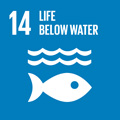- Docente: Elena Fabbri
- Credits: 6
- SSD: BIO/09
- Language: English
- Moduli: Elena Fabbri (Modulo 1) Marilin Profita (Modulo 2)
- Teaching Mode: Traditional lectures (Modulo 1) Traditional lectures (Modulo 2)
- Campus: Ravenna
- Corso: Second cycle degree programme (LM) in Science and Technologies for Environmental Sustainability (cod. 6055)
-
from Mar 21, 2025 to May 26, 2025
-
from Apr 11, 2025 to May 29, 2025
Learning outcomes
The interaction between stress factors from the marine environment with animal/human physiology will be the core of the teaching course. Potential impacts of pollutants will be considered, mainly addressing emerging pollutants and new conditions generated by global change. The students will learn about: main contaminants and source of discharge; impacts on animal physiology and threats to human health; principles of environmental quality assessment using biological methods (biomarkers); knowledge on integrated monitoring plans applied at the national and international levels.
Course contents
This course is part of the WACOMA curriculum: Principles of organism-environment interaction. Ocean and Human Health. Traditional and emerging risks to human and marine animal health. Ocean pollution and ecosystem health. Animal exposure to temperature changes, acidification and emerging contaminants in the marine environment. Route of contaminant exposure: adsoprtion, distribution, metabolism (basic principles) and excretion. How chemicals harm animal cells: exposure/effect scenarios; acute toxicity, chronic toxicity. Dose response relationships, non-conventional dose-response relationships. The critical importance of marine monitoring for human health and saveguard of ecosystems. Biomarker responses to environmental factors in marine sentinel organisms (invertebrates and fish). Biomonitoring plans in the marine environment.
Readings/Bibliography
Dedicated Chapters of some books and suggested papers:
BOOK: Contaminants of Emerging Concern in the Marine Environment: Current Challenges in Marine Pollution, Editors: Victor Leon, Juan Bellas, Elsevier 2023
BOOK: An Introduction to Toxicology. Philip C. Burcham. Springer (available online)
Teaching methods
Frontal lessons and lab practices
Assessment methods
The final exam aims at evaluating the achievement of the teaching objectives by verifying the knowledge on: Ocean and Human Health. Traditional and emerging risks to human and marine animal health. Route of contaminant exposure. How chemicals harm animal cells. The critical importance of marine monitoring for human health and saveguard of ecosystems. Biomarker responses. Development of Biomonitoring plans in the marine environment. The (written) exam will focus on three specific questions on the different topics covered. The questions are open-ended questions to which the student will be asked to provide concise but pertinent answers. A question on a general topic, one on a more focused aspects and one on the organization of an environmental assessment / monitoring action.
Teaching tools
Power point slides, scientific papers, lab manuals
Office hours
See the website of Elena Fabbri
See the website of Marilin Profita
SDGs


This teaching activity contributes to the achievement of the Sustainable Development Goals of the UN 2030 Agenda.
